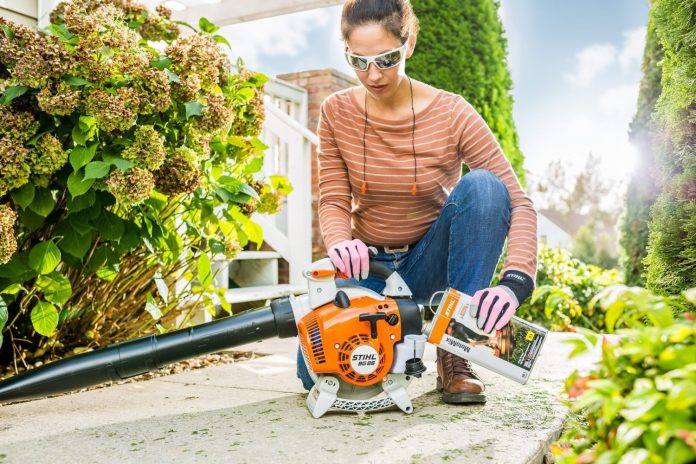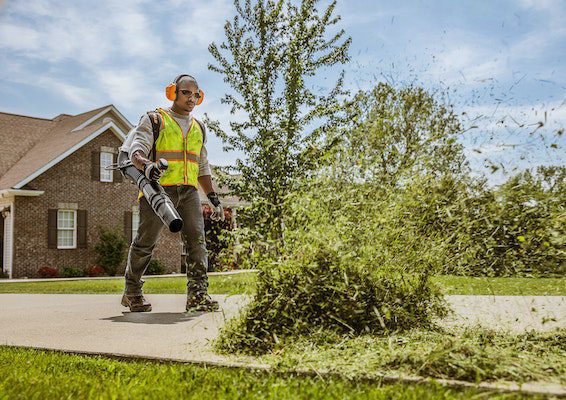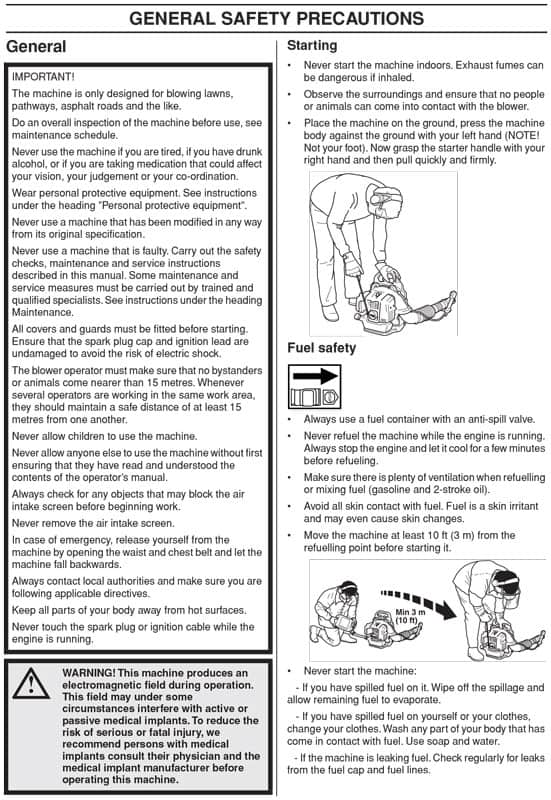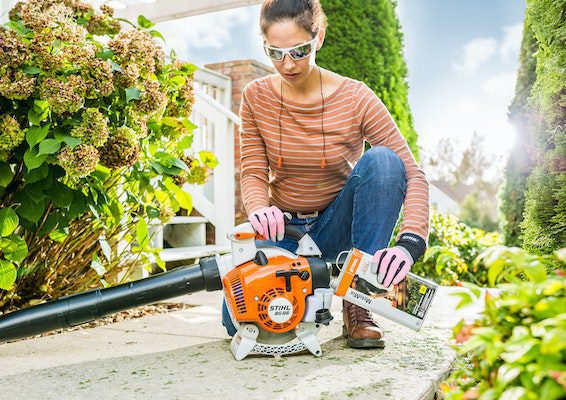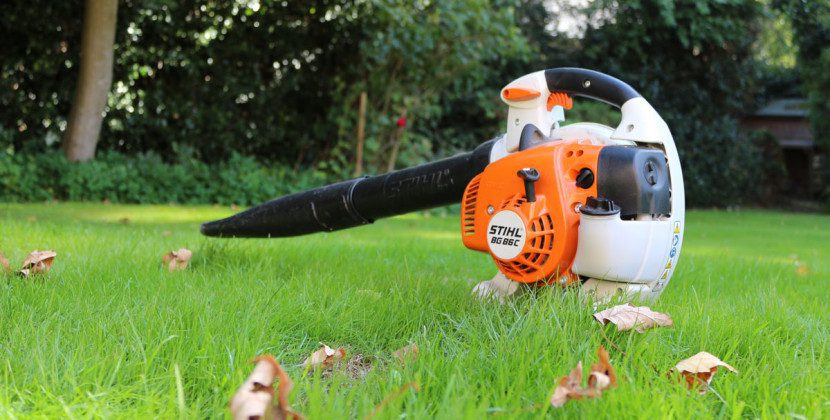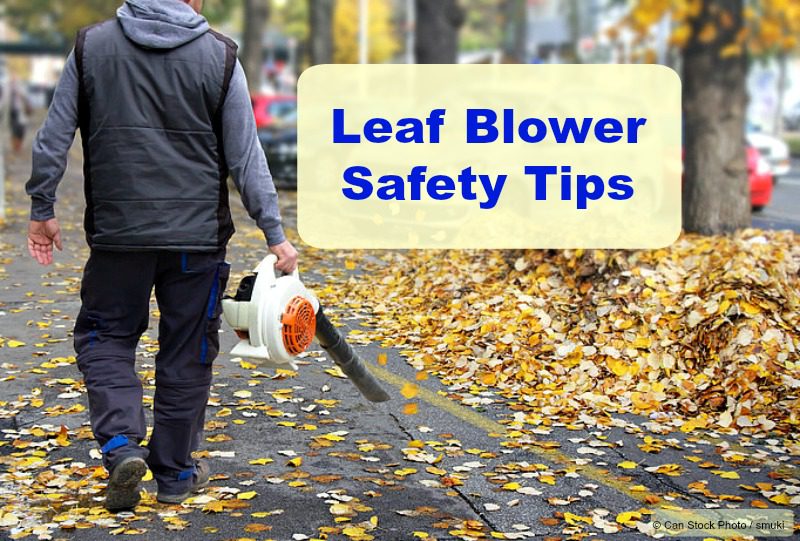I was wondering how to stay safe while using a leaf blower. Look no further!
This article will guide you through the essential safety precautions you should always consider when operating a leaf blower.
Whether you’re a seasoned pro or a first-time user, these tips will ensure that your leaf-blowing experience is efficient and accident-free.
While using a leaf blower, Let’s explore the necessary precautions to protect yourself, others, and your surroundings.
Clothing and Personal Protective Equipment
Wear appropriate clothing
When operating a leaf blower, it is essential to wear appropriate clothing that will protect you from potential hazards. This includes wearing long pants and a long-sleeved shirt to protect your skin from debris and possible scratches. Additionally, wearing a hat or helmet is recommended to protect your head from falling branches or objects. Closed-toe shoes are essential to protect your feet from any sharp objects or debris on the ground.
Use hearing protection
Leaf blowers can generate noise levels that may harm your ears, especially if you are using them for prolonged periods. It is recommended to use earplugs or earmuffs while operating a leaf blower to protect your hearing. These will help to reduce the noise and prevent any potential damage to your ears.
Use eye protection
When using a leaf blower, protecting your eyes from flying debris, dust, and other particles in the air is essential. Wearing safety goggles or a face shield will provide a barrier to protect your eyes from any potential hazards. This will prevent eye injuries and ensure you can operate the leaf blower safely.
Wear sturdy footwear
Operating a leaf blower often involves walking on uneven terrain and potentially stepping on objects that may cause injury. Sturdy footwear, such as work boots or athletic shoes with thick soles, will protect your feet and reduce the risk of accidents. These types of footwear will also provide better traction, reducing the chances of slipping or falling while using the leaf blower.
Preparation Before Using the Leaf Blower
Inspect the leaf blower.
Before using the leaf blower, it is essential to conduct a thorough inspection to ensure it is properly working. Check for loose or damaged parts, such as the nozzle, handle, or safety guards. Ensure all the controls are functioning correctly and the blower is securely assembled. If you notice any issues or defects, do not attempt to use the leaf blower and have it repaired by a professional.
Remove obstacles and debris from the area.
Before starting the leaf blower, it is essential to clear the area of any obstacles or debris that may interfere with its operation. Remove stones, sticks, branches, or any other objects that the blower could pick up and potentially cause damage or injury. Clearing the area will also help prevent tripping hazards and ensure a safe working environment.
Check for any potential hazards.
Inspect the area where you will use the leaf blower for potential hazards. Look out for low-hanging tree branches that may impede your movement or pose a danger if they fall. Check for overhead power lines or cables that could be within reach of the blower and pose electrical hazards. Identify any uneven terrain, ditches, or holes that may cause you to lose balance or trip while operating the leaf blower.
Clear the area of people and pets.
Before using a leaf blower, it is crucial to ensure no people or pets are nearby. The powerful blower’s powerful air stream can be hazardous if directed toward an individual or an animal. Clearing the area will help prevent accidents and protect the well-being of those nearby. Inform others about your intentions to use the leaf blower and ask them to stay at a safe distance until you have finished.
This image is the property of cdnassets.stihlusa.com.
Operating the Leaf Blower Safely
Hold the leaf blower correctly
Holding a leaf blower with both hands is essential to maintain proper control and balance. Grip the handle firmly, with one hand on the handle and the other supporting the blower’s tube. This will help you navigate quickly and prevent the blower from being accidentally dropped or tilted unsafely.
Avoid overexertion
Using a leaf blower requires physical exertion, especially if working for an extended period. It is essential to pace yourself and take regular breaks to prevent fatigue or strain. Overexertion can affect your balance, coordination, and decision-making abilities, increasing the risk of accidents. Remember to listen to your body and take breaks when needed.
Use the proper power setting.
Leaf blowers usually have adjustable power settings to suit different applications. When using a leaf blower, it is essential to use the appropriate power setting for the task.
Lower power settings are suitable for lighter tasks like clearing grass clippings, while higher settings may be necessary for moving heavier debris. Using the correct power setting will help you complete the job efficiently and ensure safer and more controlled operation of the leaf blower.
Do not direct the nozzle toward people or animals.
When operating a leaf blower, it is crucial to never point the nozzle at people, animals, or yourself.
The high-speed air stream produced by the blower can cause significant harm and injury, including eye damage, cuts, or bruises. Always direct the nozzle away from people and pets, ensuring the airflow is directed toward the area you want to clear.
Maintaining a Safe Distance and Angle
Maintain a safe distance from other people and property
While using a leaf blower is essential to maintain a safe distance from other individuals and objects. The airflow generated by the blower can cause debris to fly around, potentially causing injury or damage. To avoid accidents or incidents, keep a reasonable distance from people, buildings, vehicles, and other valuable property.
Keep a safe angle of use.
Maintaining a safe angle of use is essential to prevent accidental injuries or damage. Ensure that the leaf blower nozzle is pointed towards the ground or the area you want to clear.
Avoid pointing the nozzle upwards, as this can cause debris to fly high and potentially hit you or others. Keep the leaf blower at a comfortable angle to maintain control and visibility while working.
This image is the property of www.leafblowerguide.com.
Handling Fuel and Refueling
Use the correct fuel mixture
If your leaf blower operates on a fuel mixture, such as a gasoline and oil blend, it is essential to use the correct ratio recommended by the manufacturer. Using a proper fuel mixture ensures optimal performance and prevents engine damage.
Read the leaf blower’s manual to determine the appropriate fuel mixture, and always use fresh, high-quality fuel to minimize the risk of malfunctions.
Allow the leaf blower to cool before refueling.
Before refueling a hot leaf blower, allowing it to cool down completely is crucial. Attempting to refuel a hot engine can be dangerous and increase the risk of fuel igniting or spilling.
Always turn off the leaf blower and let it sit for a few minutes until it reaches a safe temperature. This precautionary measure will prevent potential accidents and help maintain the integrity of the fuel system.
Avoid spills and overfilling.
When refueling a leaf blower, take precautions to avoid spills and overfilling. Use a fuel can with a spout that fits securely into the leaf blower’s fuel tank to minimize the chances of accidental spills. Refuel slowly and carefully, paying attention to the fuel level to avoid overfilling. Wipe off spilled fuel immediately and clean the area to prevent slips, falls, or fire hazards.
Store fuel in appropriate containers
Proper fuel storage is essential to prevent accidents and maintain its quality—store fuel in approved containers specifically designed for holding flammable liquids. Ensure the containers are tightly sealed and stored in a cool, well-ventilated area away from ignition sources. Keep fuel containers out of reach of children and away from heat, direct sunlight, or open flames.
Avoid Operating in Hazardous Conditions
Do not operate the leaf blower in high winds or rain.
Operating a leaf blower in extreme weather conditions can be dangerous and increase the risk of accidents. Avoid using the leaf blower during high winds, as the force of the wind can affect your control and lead to debris flying unpredictably. Similarly, do not use the leaf blower in rainy or wet conditions, as this can create slippery surfaces and potentially damage the blower’s electrical components. Wait for calmer weather conditions before operating the leaf blower.
Avoid operating near flammable materials.
Leaf blowers generate heat and sometimes emit sparks, mainly if malfunctions or loose components exist. To avoid the risk of fire, it is important not to operate the leaf blower near flammable materials such as dry leaves, gasoline, oil, or other highly combustible substances. Keep safe from potential ignition sources to prevent accidents or fire spread.
Do not use in areas with poor visibility.
Operating a leaf blower in areas with poor visibility can be hazardous for the operator and those around them. Limited visibility increases the chances of accidents, making it challenging to identify potential hazards or navigate safely. Avoid using the leaf blower in foggy, smoky, or dusty conditions impairing visibility. Wait for improved visibility or consider alternative methods for leaf removal.
This image is the property of cdnassets.stihlusa.com.
Proper Maintenance and Storage
Regularly inspect and maintain the leaf blower
Regular inspections and maintenance of the leaf blower are crucial for its safe and efficient operation. Check the air filters, spark plug, and other components regularly, and clean or replace them as necessary. Ensure all moving parts are properly lubricated to prevent unnecessary wear and tear. Following the manufacturer’s recommended maintenance schedule will help prolong the lifespan of the leaf blower and ensure that it continues to operate safely.
Ensure the leaf blower is stored safely.
When not in use, storing the leaf blower safely and securely is essential. Store the leaf blower in a dry location, preferably indoors, away from moisture, extreme temperatures, and direct sunlight. Make sure it is placed out of reach of children and pets. Proper storage will protect the leaf blower from damage and reduce the risk of accidents caused by unauthorized use or mishandling.
Keep the leaf blower clean and dry.
Leaf blowers can accumulate dirt, debris, and moisture during operation, affecting their performance and safety. Clean the leaf blower regularly, removing any accumulated debris and ensuring that the vents and air intake are clear. Avoid using water or cleaning solutions on electrical components, and always follow the manufacturer’s instructions for cleaning. Keeping the leaf blower clean and dry will optimize its functionality and reduce the risk of malfunctions.
Know the Local Regulations
Be aware of any local noise regulations.
Many cities and municipalities have noise regulations to protect the environment and residents from excessive noise pollution. Before using a leaf blower, familiarize yourself with the local noise regulations and comply with the specified noise limits. Being considerate of others will help maintain good relationships with your neighbors and contribute to a more peaceful and harmonious community.
Follow any restrictions regarding leaf blower use.
Certain areas or communities may have specific restrictions or bans on using leaf blowers. It is essential to be aware of such restrictions and comply with them. Some areas may limit leaf blowers to specific times or days of the week, while others may have designated areas where leaf blowers are not allowed. Understanding and respecting these restrictions will help you avoid potential penalties or conflicts.
This image is the property of www.htsspares.com.
Safety Tips for Corded Leaf Blowers
Avoid running over the cord.
Corded leaf blowers require extra caution to prevent accidents caused by inadvertently running over the power cord. Be aware of the cord’s location, and avoid placing it in the blower’s path or underfoot. Use additional extension cords if needed, but ensure they are rated for outdoor use and adequately secured to prevent tripping hazards. Organizing and managing the cord will help maintain a safe and efficient operation.
Use a ground fault circuit interrupter (GFCI)
When using a corded leaf blower, it is essential to plug it into a ground fault circuit interrupter (GFCI) outlet. A GFCI is designed to detect electrical faults and quickly cut off power, reducing the risk of electrical shock or electrocution. If your outdoor outlets are not GFCI-equipped, consider using a portable GFCI adapter or hire a qualified electrician to install GFCI outlets in the designated areas.
Ensure the cord is rated correctly and in good condition
To ensure safety when using a corded leaf blower, it is essential to use a power cord rated for outdoor use and capable of handling the blower’s power requirements. Check for any signs of damage, such as cuts, fraying, or exposed wires, and do not use a damaged cord. Repair or replace any damaged cords immediately to prevent electrical hazards.
Safety Tips for Battery-Powered Leaf Blowers
Follow the manufacturer’s instructions for charging.
When using a battery-powered leaf blower, following the manufacturer’s instructions for charging the battery is crucial. Use the charger specifically designed for the battery type and model. Avoid charging the battery near flammable materials or in excessively hot or cold environments. Overcharging or using incompatible chargers can cause battery damage or even lead to fire hazards.
Use proper storage and disposal for batteries.
When not in use, store the battery in a cool, dry place and keep it away from metal objects or other batteries that could cause a short circuit. Follow the manufacturer’s instructions for proper battery disposal or recycling when the battery reaches the end of its useful life. Improper handling and disposal of batteries can pose environmental risks and harm humans and animals.
In conclusion, operating a leaf blower safely requires a combination of proper clothing, personal protective equipment, and adherence to a set of precautions and guidelines. You can minimize the risk of injuries by wearing appropriate clothing, such as long pants, long-sleeved shirts, sturdy footwear, and eye and hearing protection.
Before using the leaf blower, inspect it for any damage or defects, clear the area of obstacles and potential hazards, and ensure no people or pets are nearby. Hold the leaf blower correctly during operation, use the appropriate power setting, and avoid directing the nozzle toward people or animals.
Maintain a safe distance and angle while working and handle fuel and refueling with care to prevent accidents. Avoid operating the leaf blower in hazardous conditions, practice regular maintenance and proper storage, and abide by local regulations and restrictions.
Whether using a corded or battery-powered leaf blower, always follow the specific safety tips for each type. By following these safety precautions, you can enjoy the benefits of a clean and well-maintained outdoor environment while minimizing the risks of operating a leaf blower. Stay safe, and happy leaf-blowing!
This image is the property of www.atlantic-foundation.com.

